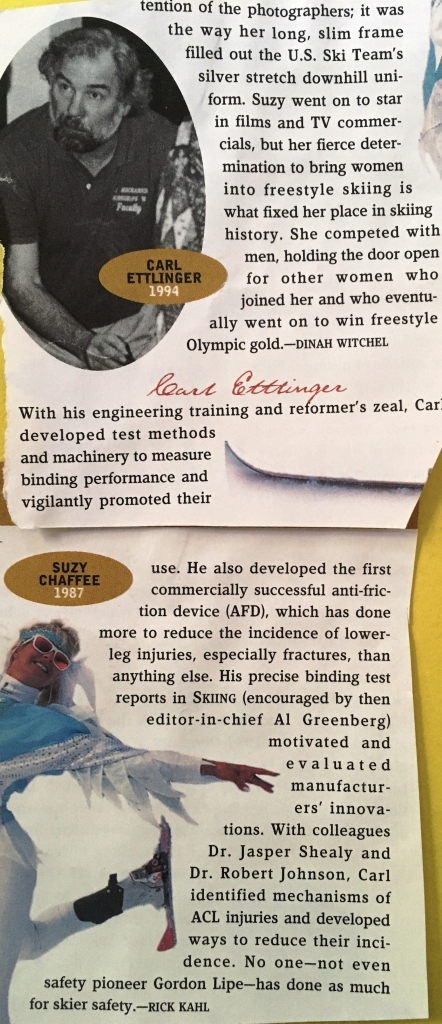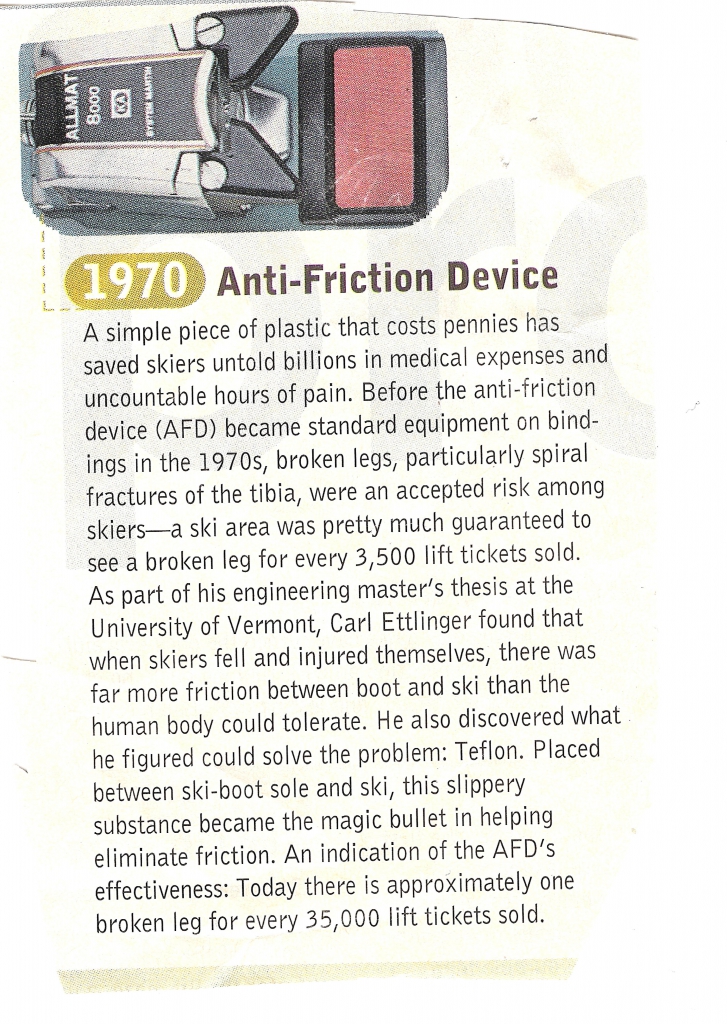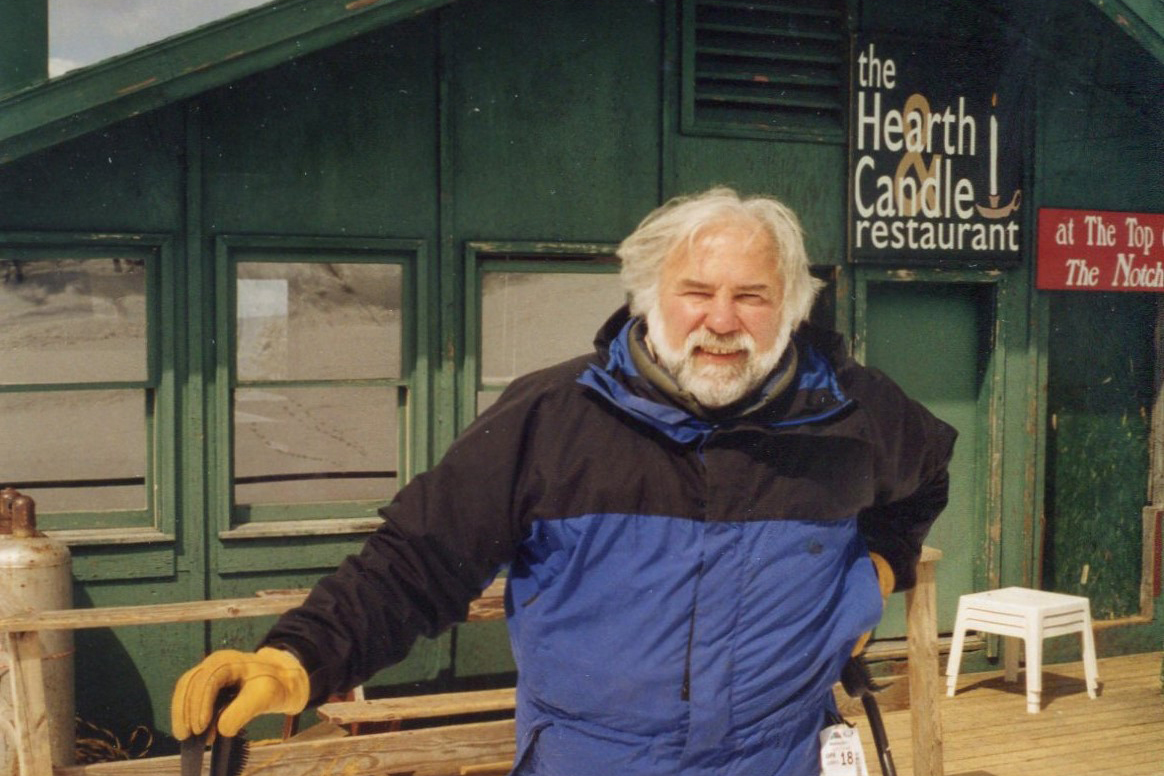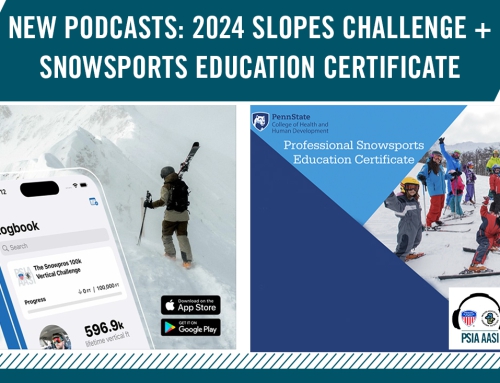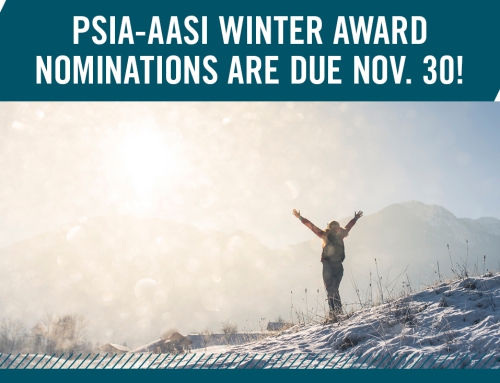Remembering Carl Ettlinger
By PSIA Alpine Team member Heidi Ettlinger
On June 19, 2020 Carl Ettlinger passed away peacefully at his home in Underhill Center, VT from Parkinson’s disease attributable to his service as a Combat Engineer Officer in the 25th Infantry in Vietnam. Carl’s principles, knowledge, grit, and courage never wavered. His outsized personality and fierce dedication to the cause of skier safety left a lasting imprint on everyone he met. Over the course of his lifetime Carl became a distinguished researcher, discovering methods to reduce ski injuries which led to the production of testing devices, training workshops, and videos to make skiing a safer sport.
His collaborative research and resulting innovations have saved the skiing public from tibial fractures costing conservatively by an estimated $600 million dollars annually. Carl was recognized by the American Society of Testing and Materials (ASTM) with the honorary title of Fellow for “meritorious and dedicated leadership of the ASTM International Committee F27 and for conducting the seminal research that provided the technical basis for standards that have materially improved skiing safety worldwide.” Carl also received the Carson White Golden Quill Award for Outstanding Contributions to the Advancement of Snowsports by the North American Snowsports Journalists Association.
Carl grew up on Staten Island, New York where his passion for sports began early in life with skiing and sailing at the forefront. He was an avid and skilled sailor who even at a young age raced and sailed the Atlantic Coastline. During his high school years he shined as both an athlete and student. He was voted the most valuable player of his football team and won the Lou Gehrig Award for sportsmanship and courage. He continued to play football as a starting fullback for the University of Vermont, while at the same time declining the opportunity to join a fraternity, instead using the money to buy a season’s pass to Stowe Mountain Resort. He began building his vast network of ski industry associations while hitchhiking from UVM to Stowe at every opportunity.
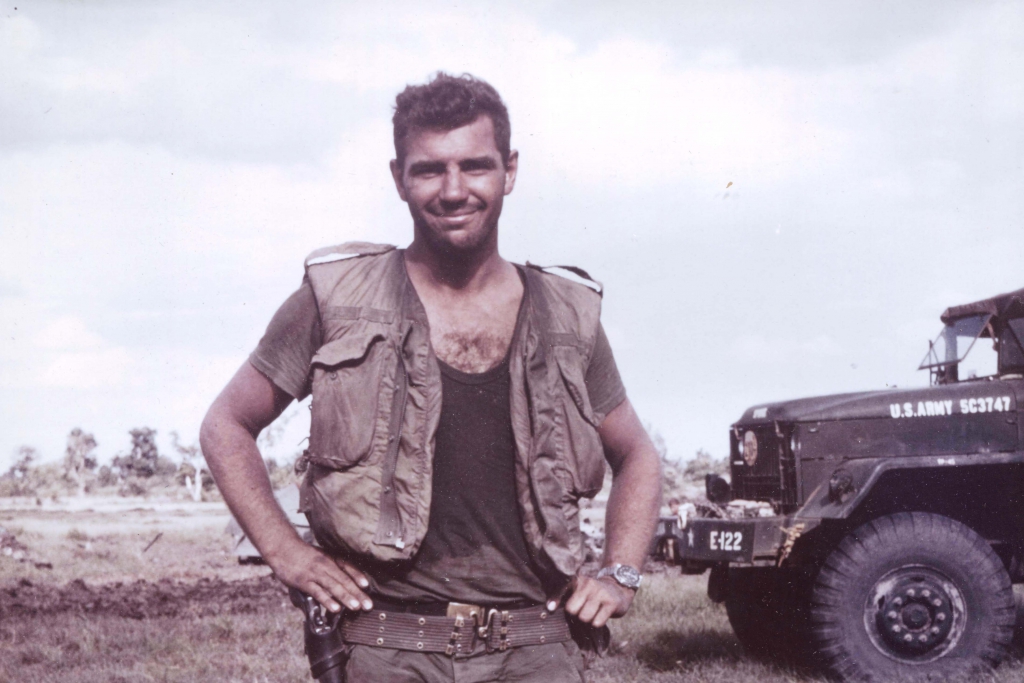
His Early Career as a Ski Safety Crusader
His professional career in snowsports began shortly after serving as a decorated second lieutenant in the U.S. Army in Vietnam from 1967 to 1968. He played a pivotal role as an innovative engineer in ensuring safety while conducting the first air deployment of tactical bridging in combat, first provisional land clearing team, and the largest use of hand-placed demolitions above ground. He was highly recognized by his commanders, receiving the Bronze Star and Vietnamese Cross of Gallantry upon discharge.
Upon returning to the University of Vermont in 1969 to complete his Masters in Mechanical Engineering, Carl continued his military involvement, joining the Vermont Army National Guard, where he served as Special Projects Officer until retiring as a captain. He helped expand and develop the historic Ethan Allen facilities including the artillery range and the first permanent biathlon training center.
Carl’s frontline experiences during his tour in Vietnam cast a long shadow across the rest of his professional and personal life. Carl’s obsession with avoiding unnecessary injuries carried over from combat to civilian life, fueling his drive to cull the cruelty of debilitating injury from a sport he loved, appropriately, down to his bones. His wartime service put Carl in harm’s way, planting the insidious seeds of disease that would eventually claim his life.
Carl’s meticulous focus on safety and passion for skiing continued while working under Prof. John Outwater at UVM. His 1970 Master’s thesis, “On the Prevention of Ski Injuries,” laid out the case for the cause of, and solution to, tibia fractures in Alpine skiing. His penchant for teaching emerged during his time as an assistant instructor for mechanical engineers at UVM.
His thesis work determined fractures were attributed to failures of the ski/boot/binding system due to boot-ski friction, incompatible boot-binding combinations, and inappropriate calibration of the release system. This resulted in development of the first commercially successful anti-friction device (AFD). It was also during this time that Carl established Vermont Ski Safety Equipment (VSSE) in the process creating the world’s leading laboratory for testing, designing, and analyzing snowsports equipment at his shop in Underhill, Vermont.
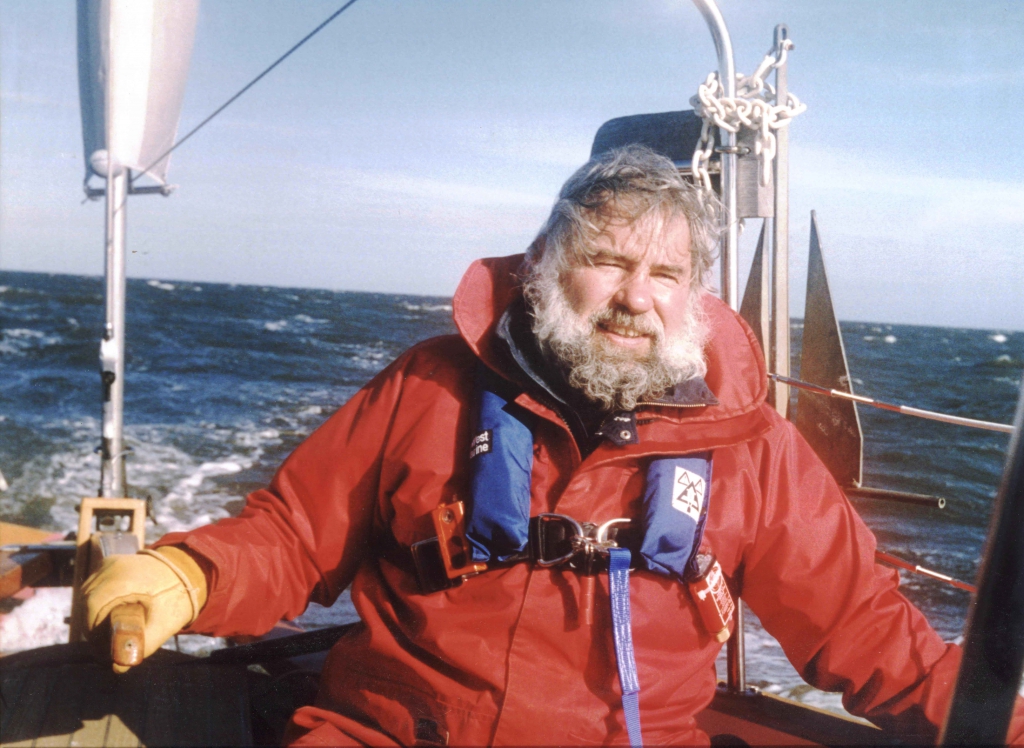
Expansion of VSSE and Development of ASTM F-27 Committee on Snow Skiing
After the incorporation of VSSE in the early 1970’s, Carl produced the Vermont Release Calibrator, an invention that would provide his greatest commercial success. (It bears mention here that Carl plowed nearly every penny he made back into his research.) In this same period, the American Society for Testing and Materials formed a new sub-committee, F-8.14, dedicated to skier safety. Naturally, Carl was a founding member of the committee known today as ASTM F-27 Committee on Snow Skiing. He would eventually chair several subcommittees, including two pivotal assignments, binding specifications and shop practices.
Beginning in 1977 Carl was also the Technical Delegate to the ISO/TC83 (International Standards Organization), shepherding through the adoption of new testing methods and common installation and inspection procedures, resulting in consistent practices being promoted by all binding technical manuals.
The process of standards development is long, excruciatingly meticulous, often contentious and usually invisible. When standards work, they go about their business in the background, protecting consumers from risks they never knew existed. This is the role of such key standards as those for boot sole dimensions and binding release setting methods, seemingly innocuous necessities that together with the development of the Teflon AFD helped virtually eradicate tibial fractures.
But while such technical toil as developing binding specifications remains largely out of public view, Carl’s role as champion of two new standards for retail and rental shop practices made him the public face for changes the dealer community was unprepared for at the time.
Directly as a result of his research, Carl developed new ski boot and binding interfaces and release mechanisms that are still used today. Carl’s binding calibration invention in the early 1970’s was such a monumental success that at one time more than 95 percent of American ski shops were using his calibrator. Today, several thousand of his binding testers are still in use worldwide. The profit from calibrator sales was used to expand his laboratory and fund his research.
Given the breadth of his expertise, Carl was well suited to the role of Technical Editor for Skiing magazine, where he served from 1972 until 1993. Working with the full support of his editor, Al Greenberg, Carl wrote unbiased reviews on alpine binding functionality, conducted product testing and wrote safety-related articles. Carl’s contributions totaled more than 120 feature articles as principal author, plus more than 200 short subjects and trade articles.
He also authored or co-authored more than 70 peer-reviewed journal articles and abstracts – most of them in collaboration with his longtime friends and colleagues, Dr. Robert Johnson and Dr. Jasper Shealy – in some of the most highly regarded publications covering sports medicine, epidemiology, injury prevention, and safety. Many of these papers served to guide and inform the International Society for Skiing Safety (ISSS), a global, multidisciplinary institution that advances safety issues and injury care in snowsports through education, research and development in all related fields.
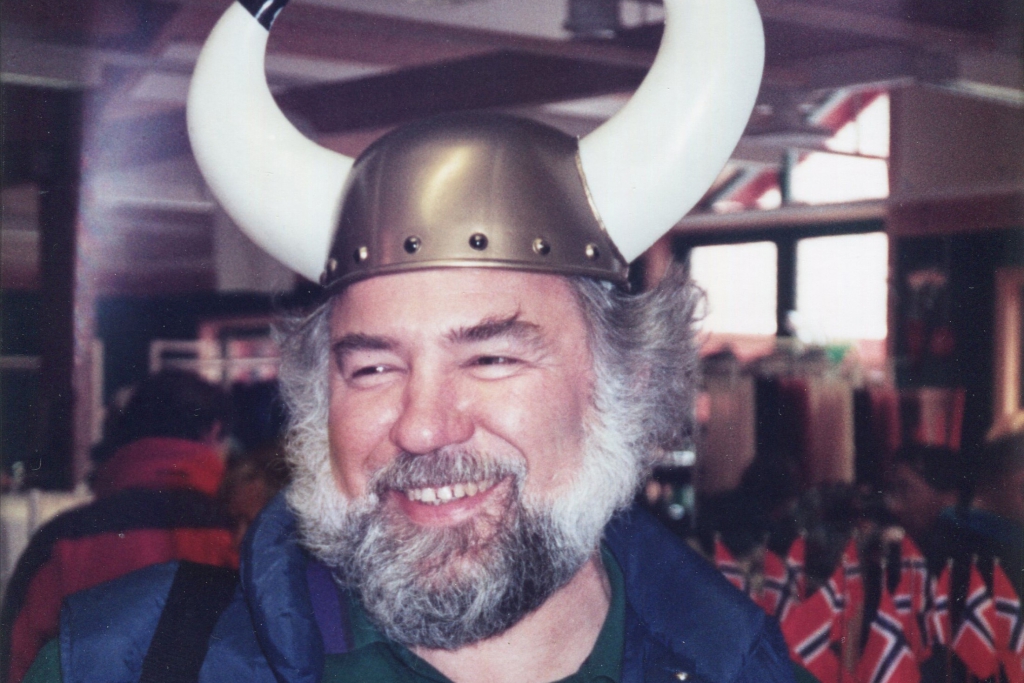
Ski Mechanics Workshops: Establishing Best Practices for using ASTM Standards in the Field
Carl’s research and understanding of binding and boot interfaces, along with his calibration testing machines, led him to help develop the first nationwide Ski Mechanics Workshops and roving educational seminars, beginning in 1972 and continuing until 2015. Produced in conjunction with SIA and NSAA, these programs trained thousands of retail and rental technicians – more than 2,000 mechanics every season – in how to implement best practices. “Learning by doing was key,” Carl noted in a 2017 article. “Everyone in the workshop was able to tighten the screws”—literally—“and see what it feels like to apply the necessary, but not excessive, torque to the binding.” The workshops were collaborative. Shop owners and technicians merged with binding manufacturers in an environment of shared learning. As international standards were adopted, boot and binding technical manuals worldwide were virtually identical, dramatically aiding in the training and education of rental/retail technicians everywhere.
Carl’s research—in conjunction with colleagues Shealy and Johnson—led to groundbreaking ASTM standards that triggered dramatic improvement in snowsports safety. The global understanding that resulted from these scientists’ research has directly led to the adoption of the core standards employed by ski equipment manufacturers worldwide.
The ASTM standards – F944 Standard Specification for Properties of Adult Alpine Ski Boots, F939 Standard Practice for Selection of Release Torque Values for Alpine Ski Bindings, F1061 Standard Specification for Ski Binding Test Devices, F1062 Standard Test Method for Verification of Ski Binding Test Devices, F1063 Standard Practice for Functional Inspections and Adjustments of Alpine Ski/Binding/Boot Systems, F1064 Standard Practice for Sampling and Inspection of Complete and Incomplete Alpine Ski/Binding/Boot Systems in Rental Applications, F473 Standard Specification for Binding Mounting Area Dimensions on Alpine Skis and Bindings, F504 Standard Test Method for Measuring the Quasi-Static Release Moments of Alpine Ski Bindings (testing the ski/binding/boot systems), F1017 Standard Test Method for Testing Lateral Toe Release of Adult Alpine Ski Bindings Under Impact Loading – in fact, virtually every relevant ISO standard relating to snowsports – has originated from ASTM standards developed directly by Shealy, Johnson and Carl Ettlinger.
For many years, ASTM F-27 conducted its annual committee meetings on Lake Champlain in Vermont aboard Carl’s 32-foot Westsail, “Excalibrater.” After a day of haggling over minutia, Carl’s warmth and gregarious nature would dispel all frustrations as he shared his memories, his friendship and his tireless urge to inform, instruct and inspire. He would always extend an open invitation to help sail down the Atlantic Coastline in the late fall.
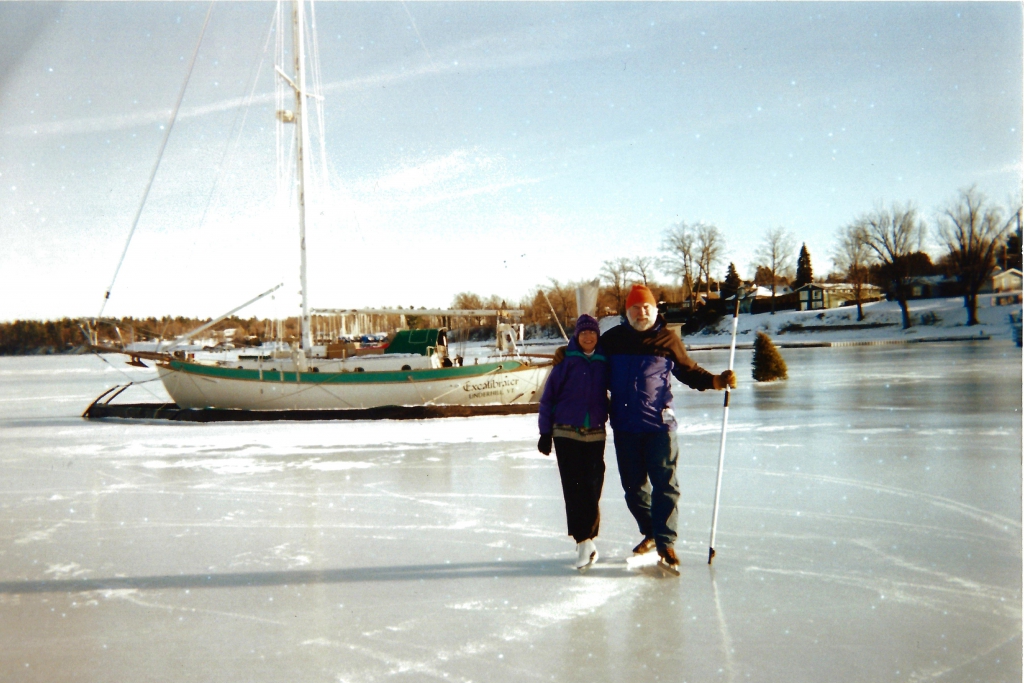
The Sugarbush Study, ACL Awareness Programs and Innovative Binding Design
In 1971, Carl, along with Drs. Shealy and Johnson, created America’s first formalized snowsports injury research program in Vermont, establishing the world-leading Sugarbush Ski Injury data collection set from the Sugarbush ski resort in Vermont (Sugarbush Study). The Sugarbush Study gave the American ski industry – resorts and manufactures alike – a huge competitive advantage over European researchers. Engineers, biomechanical experts, doctors, epidemiologists, and other scientists around the world consistently recognize the Sugarbush Study as the gold standard of ski injury data, and it has been used hundreds of times by scientists studying injury prevention, mitigation, trends, and other analyses.
Physicians from Fletcher-Allen Clinic (based in Burlington, VT, with a satellite clinic in Sugarbush) provided the injury diagnoses, while skilled technicians examined the skis, bindings, helmets, snowboards, etc. Only a case-controlled study with its degree of time-intensive rigor can meet the requirements for statistical accuracy and comprehension essential to a successful longitudinal study. The Sugarbush Study, pioneered by Dr. Johnson in 1971, has been compiled and studied by his colleagues Shealy and Ettlinger for decades. It is the only controlled, longitudinal data set of ski and snowboard injuries in the world.
After the astonishing success of his boot and binding research and inventions, Carl – again working with Johnson and Shealy – began investigating the ACL injury epidemic among skiers. In 1992, after analyzing data from the Sugarbush Study, filming hundreds of hours of slow-motion recreational skiing, studying leg and knee epidemiology records and reports, and working with scientifically controlled study groups, Carl established Vermont Safety Research to develop an ACL injury prevention program. His Training Tips for Knee-Friendly Skiing was eventually adopted by nearly 100 ski areas across the U.S. to help reduce employee ACLs.
More than one million Training Tips for Knee-Friendly Skiing videos and brochures have been distributed to the skiing public. Carl’s research and mitigation program was the first – and still the most successful – knee injury prevention program in the country. In light of his passion and achievements, Snow Country Magazine named Ettlinger the “Knight of Knees.”
“Nobody’s done more research [on lower-body injuries from skiing],” said Dr. Robert Hintermeister, of Vail’s Steadman-Hawkins Sports Medicine Foundation, in Snow Country Magazine (Sept.1994). “He’s been following the ski-injury scene longer than anyone.” The Sugarbush Study’s contribution to the field of snowsports is incalculable. Its groundbreaking research and resulting standards have had more worldwide impact on the reduction of ski injuries than any other body of work.
While Carl’s enormous scientific output has not gone unrecognized, neither has it been fully appreciated, much like the man himself. For Carl was more than the preeminent advocate for skier (and rider) safety of his generation; he was a man of outsized generosity, brilliant conversation, dancing wit and enduring warmth. We will all miss him greatly, whether we knew him or not.
In 2006 Carl and colleague David Dodge would combine their decades of knowledge and research together to form Vermont Safety Developments. Their understanding of ski binding engineering principles and the mechanism of injury for ACL injuries, helped them innovate traditional bindings with an “intelligent platform.” Together, they created several patented binding designs that could more accurately measure and respond to injury producing loads. Using video analysis and a newly developed force plate that was able to measure ski/binding/boot system loads in both magnitude and location along the ski they were able to identify areas of excess binding retention and force/couple combinations that were associated with injury. This led to patented binding designs that are able to measure not only dangerous twisting/bending moments but the location of the forces producing those moments thus eliminating blind spots of excess retention conventional bindings are unable to resolve.
Ettlinger’s Legacy
It’s possible to draw a direct line between Ettlinger’s Master’s thesis, “On the Prevention of Ski Injuries,” and the all-but-complete elimination of the sorts of tibial fractures that prevailed when the Sugarbush study began in 1971. Ettlinger’s research demonstrated that many ski injuries were due to excessive friction at the boot/binding interface, boot/binding incompatibility and improper release setting adjustment. Ettlinger almost immediately set about attacking each of these problems with his customary tenacity.
His methods included binding component design, developing testing equipment, conducting on-going research and most pivotally, serving as the principal architect and champion for both design standards and shop practices. Standards for boot dimensions and binding specifications ensured that standard components would be interchangeable and always compatible. (Due to the explosion of interest in backcountry skiing and the gear it requires, this happy situation no longer prevails.) The adoption of shop practices that included a calibration check helped identify and filter out old, obsolescent or otherwise non-functional boot/binding pairings.
The application of Ettlinger-inspired retail ski/boot/binding inspection methods to rental fleets – a notorious source of misadjusted incompatible equipment – has prevented many skier injuries. Given the enormous size of the North American rental fleet when taken in total, the number of injuries prevented easily numbers in the tens of thousands.
Due in no small part to Ettlinger’s unflagging efforts, binding-related injuries due to bending forces dropped 80+% and injuries due to twisting forces dropped by 90% over the 30-year span that Ettlinger spent attacking the problem with his tireless zeal. Since the Sugarbush study began in the 1970’s, the overall rate of any injury to skiers in the U.S. has declined by at least two-thirds. It is estimated that the number of medically significant injuries in the U.S. as of 2010 is about 100,000 such injuries per year. Had the rate of the 1970’s prevailed to the current time, we would have had about 300,000 such injuries per year. One can once again conservatively attribute at least half of this reduction to actions where Carl was a key player.
Skiing Magazine Clips
